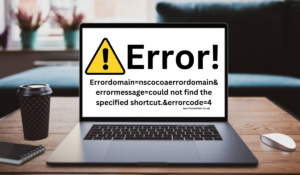
Learn how to troubleshoot and resolve the Errordomain=nscocoaerrordomain&errormessage=could not find the specified shortcut.&errorcode=4 error on macOS with step-by-step solutions and tips for fixing this issue.
Introduction
If you’ve encountered the macOS error “errordomain=nscocoaerrordomain&errormessage=could not find the specified shortcut.&errorcode=4,” you may be feeling frustrated and confused about what went wrong and how to fix it. This error is typically related to missing or broken shortcuts, and it can appear when trying to access system or user-defined shortcuts on macOS. While this issue may seem daunting at first, it is not as complex as it seems. In this blog post, we will explore the details of this error, why it occurs, and how to resolve it effectively with practical troubleshooting steps.
What Is “errordomain=nscocoaerrordomain&errormessage=could not find the specified shortcut.&errorcode=4”?
At its core, this error means that macOS cannot locate a shortcut or alias you are trying to access. A shortcut is essentially a pointer that directs the system to a file, app, or location, but when the shortcut is broken or missing, macOS fails to follow the link, triggering this error message. The error code “4” specifically refers to a missing or inaccessible file, with an error domain of NSCocoaErrorDomain—a category for issues related to the macOS Cocoa framework.
When you see this error, macOS is essentially telling you that it cannot find the specific shortcut you’re attempting to use, which can be caused by a variety of issues. This could include accidentally deleting or moving the shortcut, problems with the shortcut path, or issues with system caches or preferences. The problem often stems from a missing or relocated file, and once you understand the cause, resolving the issue can be straightforward.
Why Does This Error Occur?
The main reason behind the error message “could not find the specified shortcut” is that the shortcut you’re trying to use points to something that no longer exists in its original location. Shortcuts and aliases in macOS are pointers or references to files, applications, or directories, and they rely on the file paths being intact. If the target of the shortcut has been moved, renamed, or deleted, macOS will trigger this error as it’s unable to resolve the reference.
For instance, if you’ve created a shortcut to a document on your desktop and then moved or renamed the document, the shortcut will no longer point to the correct file. When you attempt to access that shortcut, macOS will try to follow the link and fail, displaying the “errordomain=nscocoaerrordomain&errormessage=could not find the specified shortcut.&errorcode=4” error message.
Furthermore, system updates or software changes can also affect shortcut paths. For example, if macOS has updated an app, the associated shortcut might no longer be valid, especially if the app was moved during the update. Additionally, issues with system caches, preferences, or even corrupted data can also lead to this error, preventing macOS from properly recognizing or following shortcuts.

How to Identify the Source of the Error
Before diving into fixes, it’s crucial to identify exactly where the error is coming from. Start by noting when and where you encounter the error. Does it occur when you click a specific shortcut on your desktop, when you use a keyboard shortcut, or when launching a specific app? This can help pinpoint whether the issue is related to a missing shortcut, a broken file path, or even a system-level problem.
In many cases, this error will only affect a single shortcut, meaning the issue is localized to that specific file or app. However, in some instances, it may affect multiple shortcuts or system-wide shortcut links, which could indicate a broader problem, such as a corrupted system preference or cache.
For example, if only one shortcut fails to work but others function properly, the issue likely lies with that specific shortcut or its destination. On the other hand, if multiple shortcuts are affected, this could signal a system issue that requires more in-depth troubleshooting, such as clearing system caches or resetting preferences.
Common Causes of the Error
Several common factors could lead to the “could not find the specified shortcut” error on macOS. One of the most typical causes is a missing or deleted shortcut. If you or another user accidentally deletes or moves the target file or app, the shortcut will become broken, triggering this error. Similarly, relocated files or apps often lead to shortcuts pointing to incorrect paths, causing them to fail.
Another potential cause is corrupted preferences or system settings. If macOS’s preferences related to file handling or shortcuts get corrupted, the system may fail to properly resolve shortcut links, resulting in errors like this one. System updates or app updates can also cause shortcuts to break, especially if the update changes the location or structure of files or apps, disrupting previously functional shortcut links.
In rare cases, disk errors or a full system cache could also prevent shortcuts from functioning correctly. For instance, if your hard drive is running low on space or if system caches are overloaded, macOS may fail to load or access shortcut targets. This could lead to an error like “errordomain=nscocoaerrordomain&errormessage=could not find the specified shortcut.&errorcode=4.”
How to Fix the “errordomain=nscocoaerrordomain&errormessage=could not find the specified shortcut.&errorcode=4” Error
Step 1: Check the Shortcut Path and Target
The first step to fixing this error is to check the path of the shortcut that is causing the issue. If the shortcut is pointing to a file or app, verify that the target still exists in the specified location. For instance, if the shortcut points to a file on your desktop, make sure the file is still present. If the file was moved, renamed, or deleted, you will need to either restore the file to its original location or recreate the shortcut with the updated path.
If you’re unable to find the missing target, consider whether the file was removed during a recent system update or app update. In such cases, you may need to re-download or reinstall the file or app to restore the target.
Step 2: Recreate the Shortcut
If the target file or app is still available but the shortcut itself is missing or corrupted, try recreating the shortcut. To do this, simply navigate to the original file or app, right-click on it, and select Make Alias to create a new shortcut. Place the alias in the location where the original shortcut was, and test if the new shortcut resolves the issue.
In cases where the original target no longer exists or was deleted, you may need to restore the file from a backup. If you use Time Machine, this can be a quick way to recover lost files and shortcuts.

Step 3: Restart Your Mac
Sometimes, simple errors like this one can be resolved by restarting your Mac. A reboot clears the system’s memory and can help resolve any temporary glitches with file handling or system resources. Restarting your Mac can also reset certain cached data and preferences that might be causing the error.
Step 4: Clear System Caches and Preferences
If the error persists even after checking and recreating the shortcut, clearing system caches and preferences may help. Over time, cached data can become corrupted, leading to issues with file paths and shortcuts. You can use third-party tools like OnyX to clean system caches and reset system preferences, or you can manually delete plist files from the ~/Library/Preferences/ folder.
However, be cautious when deleting or modifying preferences, as doing so can affect system settings and app configurations. Always back up your system before making any changes.
Step 5: Update macOS
Another potential solution is to update macOS to the latest version. System updates often fix bugs related to file handling, shortcut management, and other underlying system issues. Check for updates by navigating to System Preferences > Software Update, and install any available updates. After updating, check whether the “errordomain=nscocoaerrordomain&errormessage=could not find the specified shortcut.&errorcode=4” error has been resolved.
Step 6: Check for Disk Errors
If you suspect that disk corruption might be causing the issue, run Disk Utility and use the First Aid feature to check for and repair any disk errors. Corrupted files or disk structures can cause shortcuts to break, so resolving disk errors might resolve the problem.
Step 7: Contact Apple Support
If you’ve tried all of the above solutions and are still encountering the error, it may be time to contact Apple Support for further assistance. They can help you diagnose deeper system-level issues that might be affecting your shortcuts.

Preventing Future Shortcuts Issues
Once you’ve resolved the “errordomain=nscocoaerrordomain&errormessage=could not find the specified shortcut.&errorcode=4” error, it’s a good idea to take steps to prevent similar issues in the future. One of the best ways to prevent shortcut problems is to keep your files organized and avoid moving or renaming files that are used in shortcuts.
Additionally, regularly backing up your system with Time Machine or another backup solution can ensure that you have copies of important files and shortcuts, making it easier to restore them if they get lost or corrupted. Regularly updating macOS and apps can also help prevent compatibility issues that might cause shortcuts to break.
Conclusion
The Errordomain=nscocoaerrordomain&errormessage=could not find the specified shortcut.&errorcode=4 error is a common issue on macOS, typically caused by broken, missing, or relocated shortcuts. By following the troubleshooting steps outlined in this guide, you can resolve the problem and restore your shortcuts to working order. Always ensure that your system is up to date, check your shortcuts for broken links, and consider using backup tools to protect your files and configurations from future errors.
Read Also: Universities For Psychology Majors in Hollywood Gurupengajar
